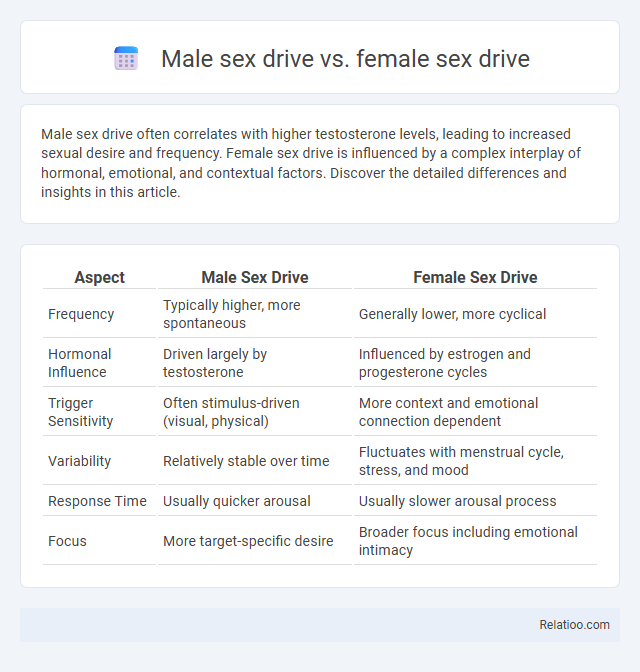Male sex drive often correlates with higher testosterone levels, leading to increased sexual desire and frequency. Female sex drive is influenced by a complex interplay of hormonal, emotional, and contextual factors. Discover the detailed differences and insights in this article.
Table of Comparison
| Aspect | Male Sex Drive | Female Sex Drive |
|---|---|---|
| Frequency | Typically higher, more spontaneous | Generally lower, more cyclical |
| Hormonal Influence | Driven largely by testosterone | Influenced by estrogen and progesterone cycles |
| Trigger Sensitivity | Often stimulus-driven (visual, physical) | More context and emotional connection dependent |
| Variability | Relatively stable over time | Fluctuates with menstrual cycle, stress, and mood |
| Response Time | Usually quicker arousal | Usually slower arousal process |
| Focus | More target-specific desire | Broader focus including emotional intimacy |
Understanding Male and Female Sex Drive
Male sex drive typically involves higher levels of testosterone, which strongly influence libido and sexual motivation, often resulting in more frequent spontaneous sexual thoughts and desires. Female sex drive is more complex and influenced by hormonal fluctuations, emotional intimacy, and contextual factors, leading to variability in sexual desire across menstrual cycles and life stages. Understanding male and female sex drive requires recognizing biological, psychological, and social differences that shape sexual motivation and behaviors in each gender.
Biological Factors Influencing Libido
Male sex drive is predominantly influenced by testosterone levels, which regulate libido intensity and frequency. Female sex drive is modulated by a complex interaction of hormones including estrogen, progesterone, and testosterone, with fluctuations during menstrual cycles significantly affecting sexual desire. Overall, sex drive is biologically governed by neuroendocrine mechanisms involving the hypothalamus, adrenal glands, and gonads, highlighting the hormonal and neural basis of libido differences between sexes.
Hormonal Differences: Testosterone vs. Estrogen
Male sex drive is primarily driven by higher levels of testosterone, which significantly influence libido intensity and sexual motivation. Female sex drive is more complex, often modulated by fluctuating estrogen and progesterone levels throughout the menstrual cycle, affecting desire differently at various phases. Overall, testosterone serves as a key hormone enhancing sexual drive in both sexes, but estrogen's role creates nuanced variations in female sexual interest and responsiveness.
Psychological Aspects of Sexual Desire
Male sex drive often correlates with higher levels of testosterone, influencing more frequent spontaneous sexual thoughts, while female sex drive is typically more responsive to contextual and emotional factors. Psychological aspects such as stress, mood, and relational intimacy play critical roles in modulating sex drive for both men and women, with women frequently exhibiting a stronger link between desire and emotional connection. Understanding your unique psychological triggers and emotional needs can enhance awareness and management of sexual desire across genders.
Gender Differences in Sexual Response
Male sex drive typically exhibits higher baseline levels of testosterone, resulting in more spontaneous sexual desire and quicker arousal patterns compared to females. Female sex drive is often influenced by complex hormonal fluctuations, emotional intimacy, and contextual factors, leading to more variable sexual responsiveness throughout the menstrual cycle. Understanding gender differences in sexual response highlights that while males prioritize physical stimuli for arousal, females generally integrate psychological, relational, and physiological components, influencing the frequency and expression of sex drive.
Social and Cultural Influences on Sex Drive
Male sex drive often reflects societal expectations of masculinity, emphasizing assertiveness and frequent sexual activity, while female sex drive is influenced by cultural norms that may prioritize emotional connection and modesty. Your understanding of sex drive should consider how socialization, gender roles, and media portrayals shape desires and behaviors differently across genders. These social and cultural influences create varying expressions of sex drive rather than purely biological differences.
Myths and Misconceptions about Male and Female Libido
Male sex drive is often stereotyped as inherently stronger and more constant than female libido, but research shows that female sex drive is equally complex and influenced by hormonal, emotional, and psychological factors. Common myths, such as men always having higher sexual desire or women being less interested in sex, ignore individual variability and the impact of social and cultural conditioning. Understanding that both male and female sex drives fluctuate naturally helps debunk misconceptions and promotes healthier attitudes towards sexual desire.
How Age Affects Sex Drive in Men and Women
Sex drive in men typically peaks in early adulthood and gradually declines with age due to decreasing testosterone levels, while women experience more complex fluctuations driven by hormonal changes such as menopause, which can reduce libido. Both men's and women's sex drive may be influenced by age-related factors including health conditions, medication, and psychological well-being, affecting the frequency and intensity of sexual desire. Understanding how your sex drive evolves with age helps address changes proactively through lifestyle adjustments and medical consultation.
Communication and Sexual Relationships
Male sex drive often centers on physical stimulation and visual cues, while female sex drive is frequently influenced by emotional connection and communication. Understanding these differences enables you to foster open dialogue, enhancing intimacy and satisfaction in sexual relationships. Effective communication bridges the gap between diverse sexual desires, promoting mutual respect and deeper emotional bonds.
Enhancing and Balancing Sex Drive in Couples
Enhancing and balancing sex drive in couples requires understanding the natural differences between male and female libido, where males often experience a more consistent and visually stimulated drive, while females' desire can be more influenced by emotional connection and hormonal fluctuations. Strategies such as open communication, stress reduction, hormonal therapies, and mutual exploration of desires help synchronize and elevate shared sexual satisfaction. Incorporating lifestyle changes, relationship counseling, and balanced nutrition further supports a healthy and passionate sex drive for both partners.

Infographic: Male sex drive vs female sex drive
 relatioo.com
relatioo.com